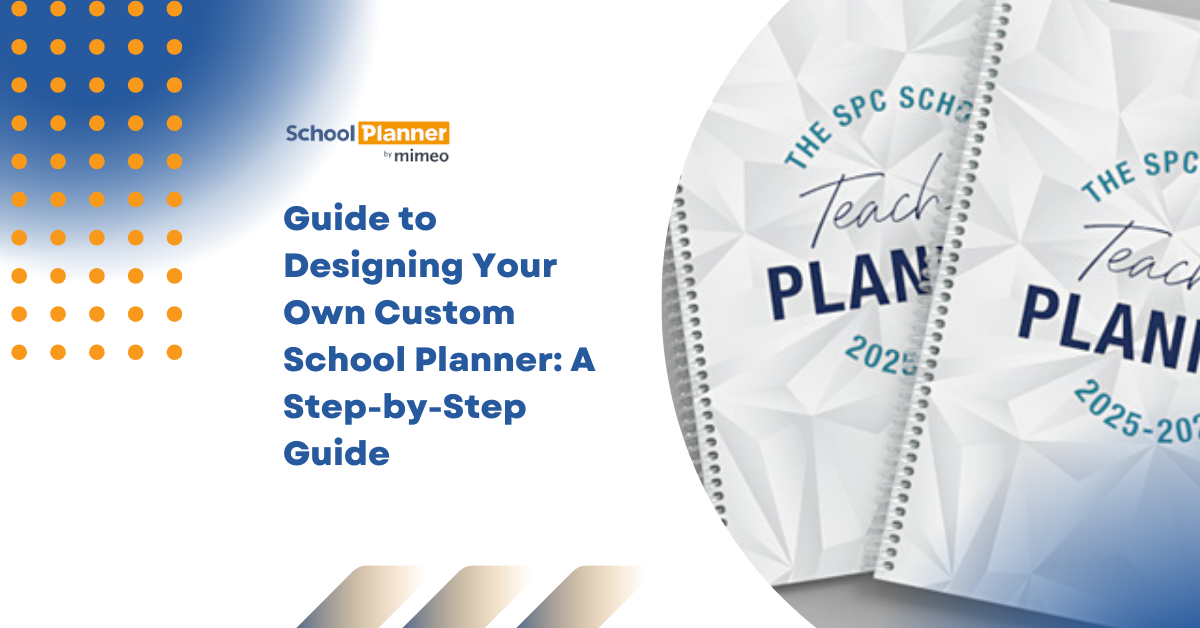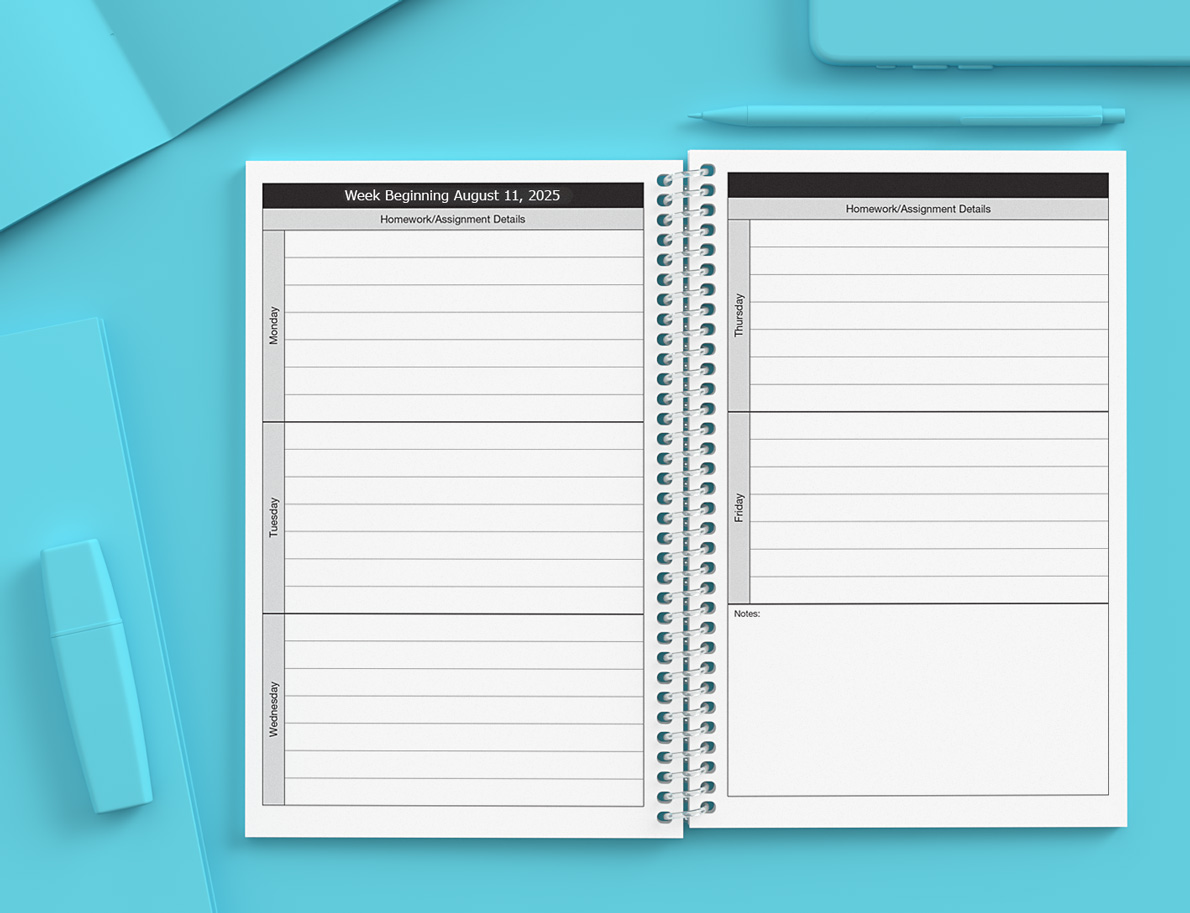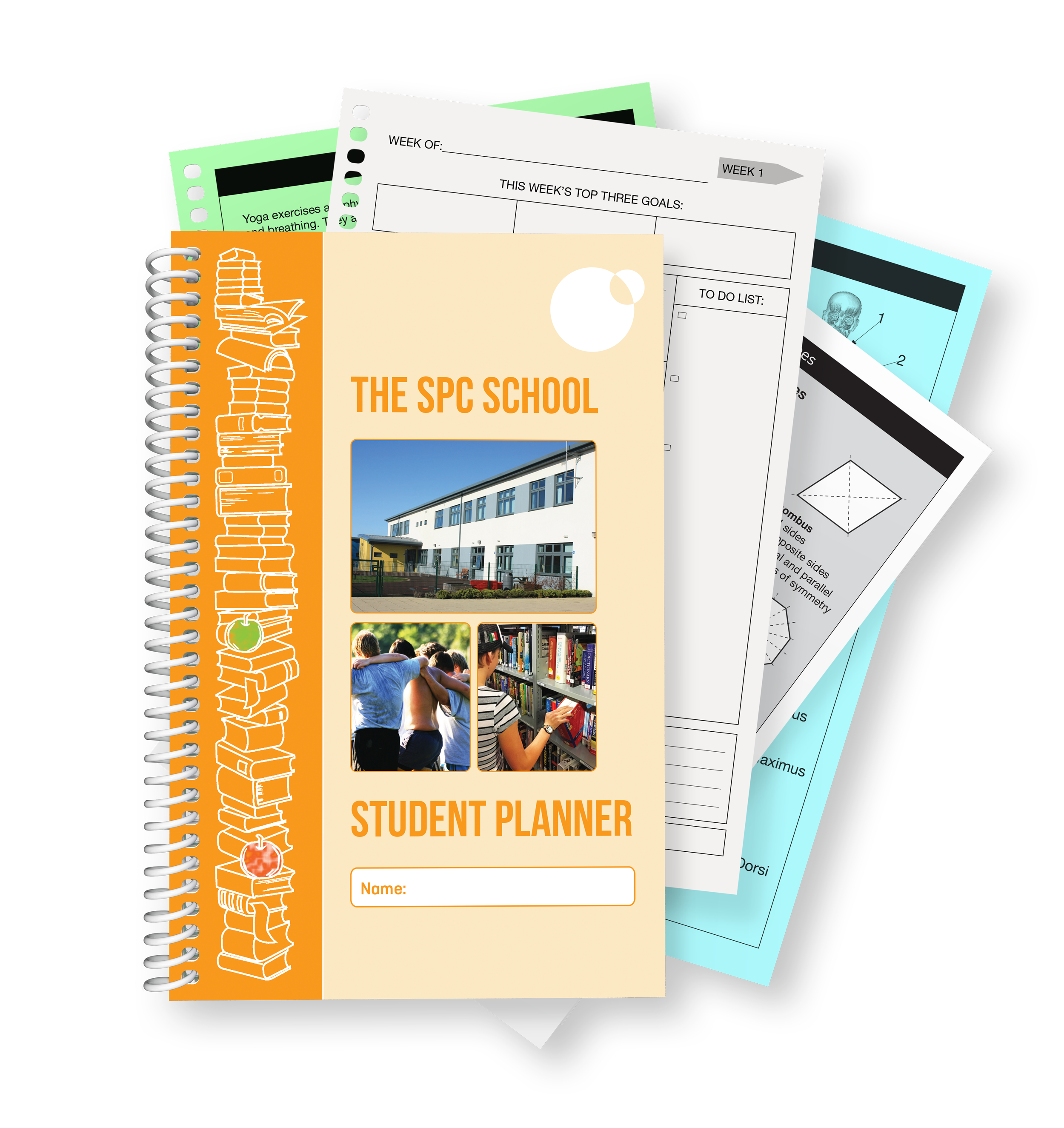In our guide to designing a custom school planner, we share more about why custom planners are a great step in helping to enhance organization and productivity for students, teachers, and parents. By designing a planner tailored to your school’s specific needs, you can create a valuable tool that fosters engagement and success. Follow this step-by-step guide to designing your own custom school planner.

Step 1: When Designing a Custom School Planner, First Define Your Planner’s Purpose
Understanding your goals will help you determine the features and layout needed for your planner. Start by identifying the primary purpose of your planner. Is it for:
- Helping students manage their time and assignments?
- Facilitating teacher-parent communication?
- Supporting goal setting and academic tracking?
Consider who will be using the planner. Tailor the design and features accordingly, as different groups have different needs:
- Elementary Students: Simple layouts with visuals, space for parent-teacher communication, and fun elements like stickers.
- Middle and High School Students: More detailed schedules, assignment trackers, and goal-setting sections.
- Teachers: Lesson planning pages, meeting notes, and professional development trackers.

Step 2: Choose a Layout Style
Decide on the overall layout of your planner. Popular options include:
- Daily Layouts: Best for detailed scheduling.
- Weekly Layouts: Great for an overview of the week’s tasks and events.
- Monthly Layouts: Ideal for long-term planning and highlighting key dates.
| Layout Type | Description | Best For |
|---|---|---|
| Daily Layout | Provides space for hour-by-hour scheduling, to-do lists, and detailed notes each day. | Teachers or students who need detailed daily schedules and task management. |
| Weekly Layout | Shows the entire week at a glance with sections for each day and space for weekly goals or notes. | Busy educators, administrators, or students balancing multiple tasks, assignments, and events weekly. |
| Monthly Layout | Displays the entire month on a two-page spread; highlights key dates, deadlines, and events. | Long-term planning, tracking major projects, academic calendars, and big-picture overviews. |
You can also mix and match layouts to suit different sections of the planner. For example, you might dedicate the first section of the planner to a monthly overview, providing a snapshot of key dates and events. The next section could focus on weekly layouts, offering more detailed spaces to break down tasks, assignments, and schedules.
Daily layouts can be included for particularly busy periods, such as exam weeks or project deadlines, allowing for a granular view of each day. This flexibility ensures the planner adapts to various needs throughout the school year, making it a truly versatile tool.
| Calendar Type | Description | Best For |
|---|---|---|
| Yearly Calendar | Provides a bird’s-eye view of the entire academic year, including major events like holidays, parent-teacher conferences, and exam periods. | Long-term planning, school administrators, and teachers mapping out curriculum pacing or major milestones. |
| Monthly Calendar | Offers a detailed look at one month at a time, helping users anticipate and prepare for upcoming events and deadlines. | Teachers, students, and parents needing mid-range planning to stay aware of tests, projects, and school activities. |
| Weekly Calendar | Breaks down the week into manageable segments for organizing day-to-day tasks, assignments, and appointments. | Daily task management, lesson planning, and student assignment tracking. |
When designing the content of the planner, it is crucial to align the features with the specific needs of your audience.
- Yearly calendars can provide a comprehensive overview of the academic year, marking significant dates such as holidays, parent-teacher conferences, and exam periods.
- Monthly calendars offer a closer look at upcoming events, helping users prepare for what’s ahead.
- Weekly calendars are perfect for planning day-to-day activities, ensuring that tasks are organized and deadlines are met.
For students, homework and assignment trackers are indispensable. These sections allow them to record due dates, required materials, and notes about each assignment, promoting better time management and reducing the risk of missed deadlines.
Similarly, goal-setting and progress-tracking pages can serve as a motivational tool, encouraging students to set academic and personal goals while monitoring their achievements over time. Teachers and parents can also benefit from communication logs that facilitate structured updates about a student’s progress, behavior, or upcoming needs. These logs create a clear channel for collaboration, ensuring everyone involved in the student’s education is on the same page.
Resource pages are another essential feature to consider. These can include study tips, reference charts, or school policies, providing users with quick access to valuable information. For example, a reference page with multiplication tables or grammar rules can be especially helpful for younger students, while high schoolers might benefit from college preparation tips or time management strategies.

Step 3: Add Branding and Personalization When Designing a Custom School Planner
Making your planner unique is an important part of the design process. Incorporating your school’s branding ensures that the planner feels like a cohesive part of the school community. This can include prominently displaying the school’s logo on the cover, using the school’s colors throughout the design, and even featuring the school mascot as a playful design element. Adding a motivational motto or quote can inspire users each time they open the planner, fostering a positive mindset.
Personalization options take the planner a step further by making it feel truly special to each individual. For instance, you can include spaces for students to write their names or fill in their class schedules, creating a sense of ownership. These small touches not only enhance the usability of the planner but also instill a sense of pride and belonging within the school community. By combining practical features with personalized elements, your custom planner will stand out as an indispensable tool for both organization and school spirit.
Step 4: Focus on Visual Design for Custom School Planners
When designing a custom school planner, keep in mind that a visually appealing planner is more likely to be used consistently and effectively throughout the school year. The design elements you choose—such as colors, fonts, graphics, and overall layout—play a significant role in making the planner both functional and enjoyable to use.
When making a custom school planner, this step allows your school’s personality to shine while ensuring usability remains front and center.
Color Choices
Incorporating your school’s colors throughout the planner not only reinforces school pride but also creates a cohesive, branded look. However, it’s crucial to balance vibrant shades with neutral tones to ensure that text remains readable and pages don’t appear cluttered. Smart use of color coding can further enhance functionality—for example, assigning one color for academic content and another for extracurricular activities helps users easily navigate the planner.
Graphics and Illustrations
Consider your audience when selecting visual elements. For younger students, playful illustrations, themed borders, or fun icons can make the planner feel inviting and engaging. For older students, teachers, and administrators, clean lines, modern typography, and subtle graphics may be more appropriate. Always aim for a balance between aesthetic appeal and practical functionality to ensure the planner remains a tool, not a distraction.
Font Selection and Layout
Clear, legible fonts are essential when designing a custom school planner, especially for planners meant for daily or frequent use. Sans-serif fonts often work best for body text, while stylized fonts can be reserved for headings or section dividers. Generous spacing and intuitive layouts make it easier to jot down notes and track tasks quickly.
When making a custom school planner, the visual design stage is your opportunity to blend beauty with purpose.
Visual Design Elements Chart
| Design Element | Description | Best Practice When Making a Custom School Planner |
|---|---|---|
| Color Scheme | Incorporates school colors and accent shades. Can also use color coding for sections. | Use school colors consistently. Balance bright and neutral tones. Apply color coding to differentiate sections. |
| Graphics & Illustrations | Includes images, icons, borders, and themed visuals to enhance engagement. | Choose playful illustrations for younger students. Opt for modern, clean graphics for older students and teachers. |
| Font Styles | Determines readability and tone through typefaces and text sizes. | Use clear, legible fonts (sans-serif preferred for body text). Limit decorative fonts to headings. |
| Layout & Spacing | Organizes content visually to ensure easy writing and reading. | Allow adequate spacing for notes and tasks. Maintain a clean, uncluttered layout for clarity. |
| Section Dividers & Tabs | Visually separates planner sections (e.g., academics, activities). | Use tabs, bold headings, or color-coded dividers for intuitive navigation. |
Step 5: Incorporate Customizable Extras
To truly make your planner stand out, consider including customizable extras that enhance its functionality and usability. One popular feature is the addition of tabs, which make it easy to navigate between sections. Tabs can be color-coded or labeled, allowing users to quickly locate the information they need without flipping through pages aimlessly.
Stickers are a fun and functional way to engage users, particularly younger students. Provide sheets of stickers that can be used to mark important dates, highlight completed tasks, or decorate the planner. Stickers can include icons for events like tests, holidays, or birthdays, as well as motivational phrases to encourage students to stay on track.

Ready to Create Your Custom School Planner?
Designing a custom school planner may seem daunting, but with careful planning and the right partner, you can create a tool that transforms organization and communication in your school. Contact us today to start designing your perfect planner or to request a free quote!